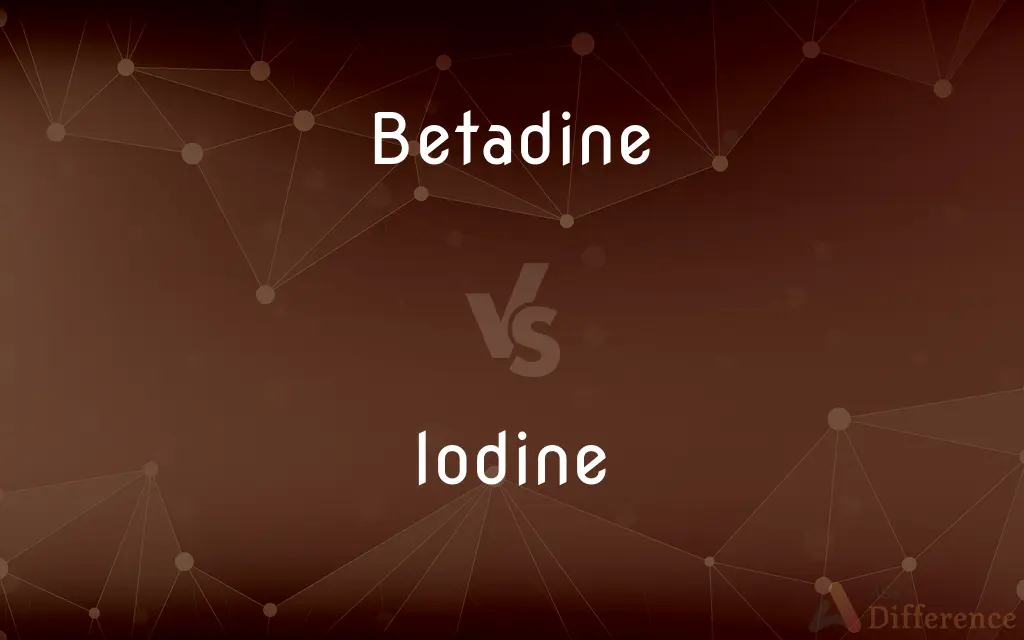Betadine vs. Iodine — What's the Difference?
Edited by Tayyaba Rehman — By Fiza Rafique — Updated on October 11, 2023
Betadine is a brand of antiseptic that contains iodine. Iodine is a chemical element used for various purposes, including disinfection. While Betadine utilizes iodine, not all iodine preparations are Betadine.

Difference Between Betadine and Iodine
Table of Contents
ADVERTISEMENT
Key Differences
Betadine is a widely recognized brand name for a povidone-iodine antiseptic solution. Iodine, on the other hand, is a chemical element with the symbol "I" and atomic number 53, found naturally in certain foods and also available in dietary supplements.
Betadine's primary component is iodine, but it's not pure iodine. It combines iodine with a carrier molecule called povidone, which allows the iodine to be released slowly, providing prolonged antiseptic action. Iodine in its pure form can be a strong oxidizing agent and can be caustic to the skin.
The use of Betadine in medical settings is often as a topical disinfectant before and after surgery or for minor wound care. Iodine can be used for similar purposes, but due to its strength, it's more commonly diluted or combined with other agents, like in Betadine, to reduce potential irritation.
Beyond its antiseptic properties, iodine is essential for human health. It plays a crucial role in thyroid function and the production of thyroid hormones. Betadine, while containing iodine, is not intended for ingestion and doesn't serve as a dietary source of iodine.
Both Betadine and iodine have a brownish color, making them easily recognizable when applied to the skin. The presence of iodine gives Betadine its characteristic color. However, while Betadine is primarily for external use, iodine has both external and internal applications, depending on its form and concentration.
ADVERTISEMENT
Comparison Chart
Nature
Brand name antiseptic
Chemical element
Composition
Contains iodine combined with povidone
Pure element or diluted in solutions
Primary Use
Topical disinfectant
Disinfection, thyroid function
Color
Brownish (due to iodine content)
Brownish or violet vapor
Intake
Not for ingestion
Essential dietary element
Compare with Definitions
Betadine
A brand containing povidone-iodine for prolonged antiseptic action.
To avoid infection, I applied Betadine to my scraped knee.
Iodine
A brownish or violet vapor when heated.
When the substance was warmed, it released a violet hue, indicating it was iodine.
Betadine
A topical agent for preventing bacterial growth.
Betadine is often found in first aid kits for its effectiveness.
Iodine
A trace element found in seafood and some salts.
To boost your iodine intake, consider eating more seafood.
Betadine
An antiseptic solution used for disinfection.
Before surgery, the nurse cleaned the area with Betadine.
Iodine
A chemical element essential for thyroid hormone production.
The body needs iodine for proper thyroid function.
Betadine
A common pre-surgical skin preparation product.
The doctor recommended using Betadine before the minor procedure.
Iodine
A strong disinfectant in its pure form.
He used iodine to disinfect the water.
Betadine
A brownish disinfectant solution recognizable by its color.
She knew it was Betadine by its distinct hue.
Iodine
Iodine is a chemical element with the symbol I and atomic number 53. The heaviest of the stable halogens, it exists as a semi-lustrous, non-metallic solid at standard conditions that melts to form a deep violet liquid at 114 degrees Celsius, and boils to a violet gas at 184 degrees Celsius.
Betadine
(pharmaceutical drug) Povidone-iodine, used as a topical antiseptic.
Iodine
Symbol I A lustrous, purple-black, corrosive, poisonous halogen occurring as a diatomic molecule, I2, that easily sublimes to give a purple gas and is a trace element essential for proper thyroid function. Radioactive isotopes, especially I-131, are used as medical tracers and in thyroid disease diagnosis and therapy. Iodine compounds are used as germicides, antiseptics, and dyes. Atomic number 53; atomic weight 126.9045; melting point 113.7°C; boiling point 184.4°C; density of gas 11.27 grams per liter; specific gravity (solid, at 20°C) 4.93; valence 1, 3, 5, 7. See Periodic Table.
Iodine
An antiseptic preparation containing iodine in solution, used to treat wounds.
Iodine
A chemical element (symbol: I) with an atomic number of 53; one of the halogens.
Iodine
An antiseptic incorporating the element.
Iodine
An iodide.
Iodine
(transitive) to treat with iodine.
Iodine
A nonmetallic element, of the halogen group of atomic number 53, occurring always in combination, as in the iodides. When isolated it is in the form of dark gray metallic scales, resembling plumbago, soft but brittle, and emitting a chlorinelike odor. Symbol I. Atomic weight 126.90. If heated, iodine volatilizes in beautiful violet vapors.
Iodine
A nonmetallic element belonging to the halogens; used especially in medicine and photography and in dyes; occurs naturally only in combination in small quantities (as in sea water or rocks)
Iodine
A tincture consisting of a solution of iodine in ethyl alcohol; applied topically to wounds as an antiseptic
Iodine
A component often combined with other agents for medical applications.
The solution had iodine combined with alcohol for skin preparation.
Common Curiosities
Can Betadine be ingested?
No, Betadine is for external use only and should not be ingested.
What is Betadine?
Betadine is a brand of antiseptic that contains iodine, specifically in the form of povidone-iodine.
Why is iodine essential for the human body?
Iodine is crucial for the production of thyroid hormones, which regulate various physiological processes in the body.
Can I use iodine as a disinfectant?
Yes, iodine has disinfectant properties and can be used for disinfection, often in diluted solutions.
What is iodine?
Iodine is a chemical element with the symbol "I" and atomic number 53, used for various purposes including disinfection and essential for thyroid function.
Is Betadine the same as pure iodine?
No, Betadine contains povidone-iodine, which is a complex of iodine with the polymer povidone. It's not pure iodine.
Are there any side effects associated with using Betadine on the skin?
Some people might experience skin irritation or allergic reactions to Betadine. It's essential to follow guidelines and discontinue use if irritation occurs.
How can I increase my iodine intake in my diet?
Consuming iodized salt, seafood, dairy products, and some vegetables can help increase iodine intake.
Can I use Betadine as a regular hand sanitizer?
While Betadine has antiseptic properties, it's primarily formulated for wound disinfection and not as a regular hand sanitizer.
What is the primary use of Betadine in medical settings?
Betadine is commonly used as a topical disinfectant before and after surgeries or for minor wound care.
Can iodine deficiency lead to health problems?
Yes, iodine deficiency can lead to goiter (enlarged thyroid) and other thyroid-related issues.
Is Betadine effective against all types of bacteria?
Betadine is effective against a wide range of bacteria, fungi, and viruses, but no antiseptic is effective against all microorganisms.
Are there alternatives to Betadine for wound disinfection?
Yes, there are other antiseptics and disinfectants available, such as hydrogen peroxide and alcohol-based solutions. It's essential to choose based on the wound type and individual needs.
What gives Betadine its distinct brownish color?
The presence of iodine in Betadine gives it its characteristic brownish color.
Should iodine be stored in a specific way?
Iodine should be stored in a cool, dry place, away from direct sunlight and out of reach of children.
Share Your Discovery

Previous Comparison
Baptist vs. Anabaptist
Next Comparison
Axe vs. HatchetAuthor Spotlight
Written by
Fiza RafiqueFiza Rafique is a skilled content writer at AskDifference.com, where she meticulously refines and enhances written pieces. Drawing from her vast editorial expertise, Fiza ensures clarity, accuracy, and precision in every article. Passionate about language, she continually seeks to elevate the quality of content for readers worldwide.
Edited by
Tayyaba RehmanTayyaba Rehman is a distinguished writer, currently serving as a primary contributor to askdifference.com. As a researcher in semantics and etymology, Tayyaba's passion for the complexity of languages and their distinctions has found a perfect home on the platform. Tayyaba delves into the intricacies of language, distinguishing between commonly confused words and phrases, thereby providing clarity for readers worldwide.













































